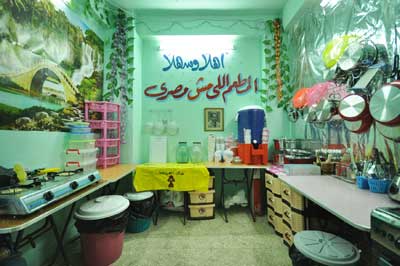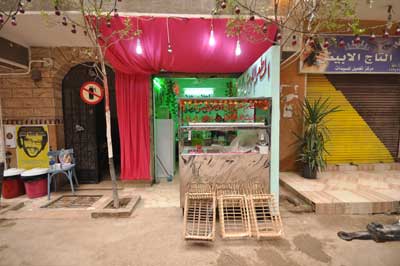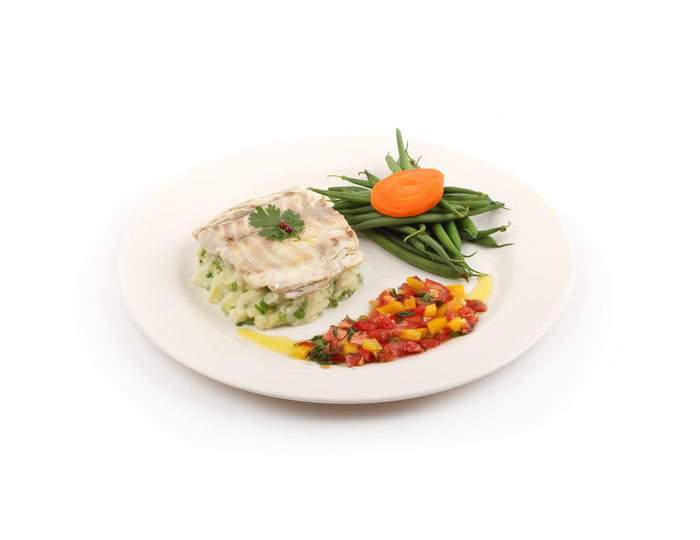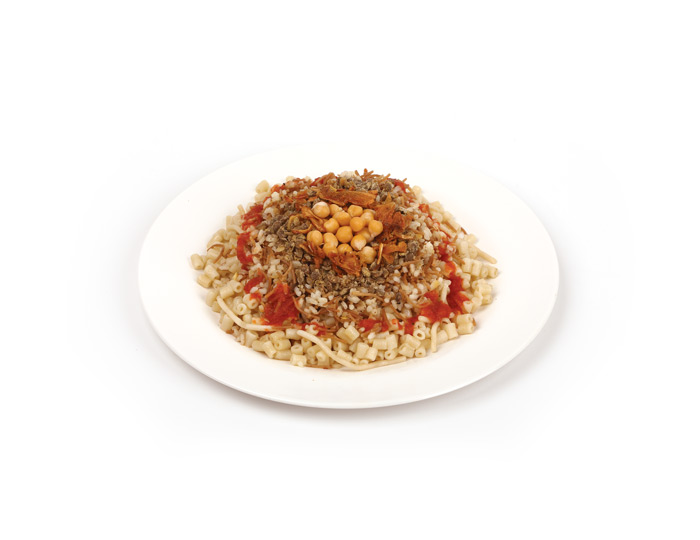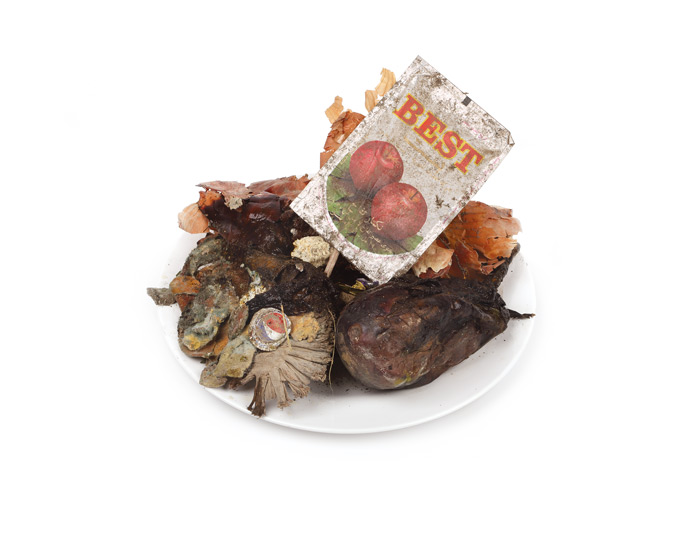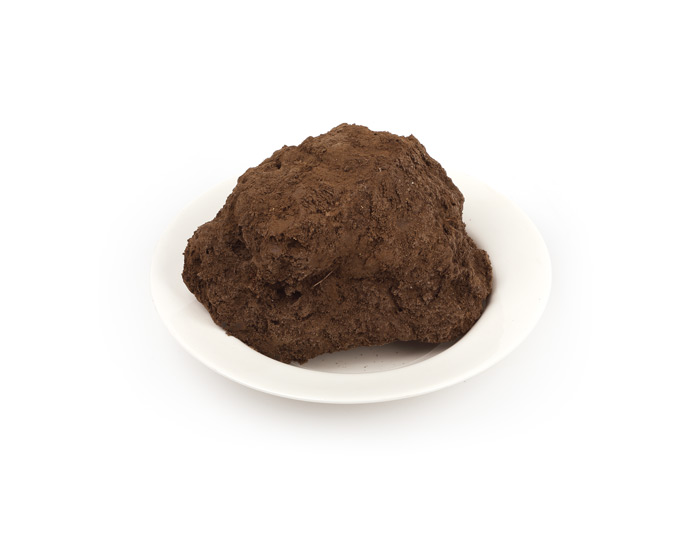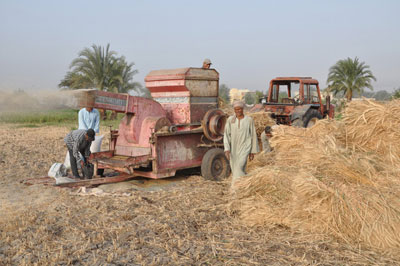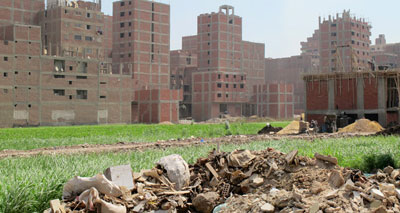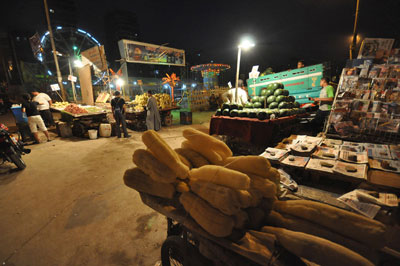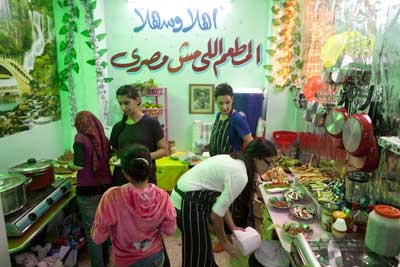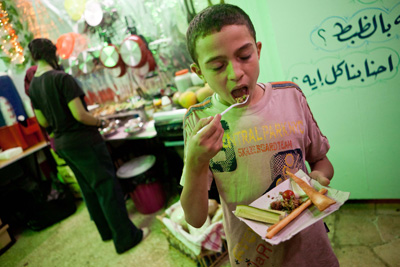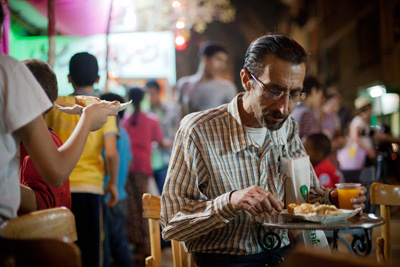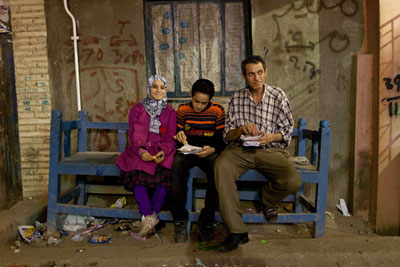El Matam El Mish Masry
This project is an instrument for common critical analysis to help understand the reasons behind Egyptians’ diminishing access to food. The title, The Non-Egyptian Restaurant makes reference to a feeling shared by many Egyptians: that they live in a country no longer their own, a country that is in “someone else’s” hands.
The work involved the creation of a small restaurant in the neighbourhood of Ard El Lewa, one of the informal settlements of Greater Cairo, through which to deal with issues related to export/import policies, as well as considering the side effects of uncontrolled growth of suburban areas on top of agricultural land.
The kitchen was installed in the dokkan at artellewa art space, in the fashion of a local popular restaurant. It opened during the entire month of November 2012 and worked according to the following menus:
Week 1 MENU 1:
Cooking with Egyptian grown products exported to the international market and rarely accessible to the Egyptian population.
Meal: Baked sea bass on a bed of royal jersey potatoes seasoned with tender chives, garnished with steamed carrots and green beans. Served with tomatoes and sweet pepper salad.
All vegetables are organically grown.
In collaboration with Elisabeth Shoghi, international 5 starts chef.
Week 2 MENU 2:
Cooking with the products available on the Egyptian domestic market, locally grown as well as imported, that are affordable for low-income families in the area of Ard El Lewa.
Meal: Koshary, a popular dish consisting of rice, lentils, chickpeas,fired onians, spicy tomato sauce and pasta made from imported wheat of low medium quality. Egyptian vegetables grown for the domestic market are often irrigated with wastewater. Pesticides and fertilizers are used without regulation by the state. Instructions for their use are often printed in foreign languages unreadable to the Egyptian farmers.
Four women from the neighbourhood, Om Islam, Om Mohamed, Om Karim and Waefá were invited to cook the recipes according to their actual household budgets.
Week 3 MENU 3:
As a symbolic act, we harvested the ingredients from the land that surrounds the restaurant, which once was agricultural land. Every day the designated area grew 200 meters, until reaching 1 km on the fourth day of the week. Finding plastic, cigarette butts, or discarded chewing gums, tomatoes, onions, lettuces…
Meal: Decomposed eggplant, soda lid, plastic bag, cigarette butts, gum, onionskins and orange peels. The found ingredients were cooked and presented merely for display purposes.
In collaboration with Solafa Ghanem and Rana Khodair.
Week 4 MENU 4:
In the fashion of an agro-archaeology exercise, we conducted a series of excavations taking as starting point the restaurant’ s backyard, looking for any signs of agricultural past and activity of the neighbourhood.
Meal: fertile soil found beneath 1.5 metres of detritus, rubble, bottles and plastic, resented, merely for display purposes.
In collaboration with archaeologist and Egyptologist Salima Ikram.
During the last decade, food has been a main concern for Egyptians. Once known as the “food reserve of the Roman Empire”, Egypt is now among the biggest importers of grain, especially wheat.
Until the middle of the 20th century, Egypt was an international major agricultural producer, its domestic production feeding almost 100 per cent of its population. This high level of self-sufficiency started to crumble down at the beginning in the 1970s-1980s, with the application of new policies on agriculture and development. This situation continued worsening to finally collapse in the Food Crisis of 2008. As a matter of fact, lack of food was a fundamental driving force of the Revolution of January 2011.
From then on, Cairo’ s suburban areas have experienced a fast and incontrollable growth, which has transformed large areas of fertile soil into constructed, paved land, thus increasing even further self-sufficiency problems.
These illegally constructed neighbourhoods, with no urban planning or public infrastructures, are popularly known as “Ashguahiyat”, a term meaning “leaving things to chance”.
Paradoxically, the inhabitants of these Ashguahiyats are mainly peasants who have been dispossessed of their land or unable to sustain themselves with its produces. These circumstances force them to migrate to big urban centres, where they are hired as construction workers.
This project is based in one of these “informal” neighbourhoods or Ashguahiyats:
Ard El Lewa located northeast of Giza.
Ard El Lewa means “the general’s land”.
text and images by Asuncion Molinos Gordos, 2012
[ top ]ANOTHER PROJECT ON CITYSHARING
→ WAM _ World Agricultural Museum
RELATED WEB SITE
→ artist’s website
[ 2nd May ]
[ Al Kheimah—The Tent ]
[ Al Maq’ad—The Bench ]
[ Altelefon Alkharban—Téléphone Cassé ]
[ El Ashaa’—The Banquet ]
• El Matam El Mish Masry •
[ Ez-zahr—The Dice ]
[ Flatlands Av. ]
[ Here I Stand ]
[ In Memory of Protest ]
[ In the Shadow of the Pyramids ]
[ Mels - A Pause For Thought ]
[ Schaffhauser Rheinufer ]
[ Shwayet mayy—Some Water ]
[ The “Made In Musina” Project ]
[ urbaninform ]
[ WAM _ World Agricultural Museum ]
FEATURED THEME ON CITY SHARING
by ASUNCION MOLINOS GORDO
-
This project is an instrument for common critical analysis to help understand the reasons behind Egyptians’ diminishing …
by INAS HALABI
-
The project Letters to Fritz and Paul focuses on the expeditions of the Swiss cousins, lovers and scientists, Fritz and …
by SARAH BURGER
-
The planned modern city of Brasilia attracted me since a long time. Her defined shape, location and function proceded he …
by ADRIEN GUILLET
-
Youri Telliug talks with the artist Adrien Guillet about his project Citracit
Youri Telliug - What is Citracit …
by NIGIST GOYTOM
-
In 2013 more than 45 million people have been forced to leave their homes. This amounts to the biggest number of refugees …
by SULAFA HIJAZI
-
The on going debate on Arab identity and its (cultural) representation is strongly shaped by Edward Saidʼs formative …
by ASUNCION MOLINOS GORDO
-
WAM is a site-specific work that uses the historical trope of the cabinet of curiosities to explore the introduction of …
MORE CONTRIBUTIONS BY THE FOLLOWING
